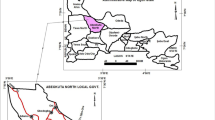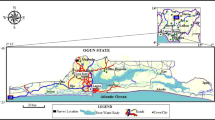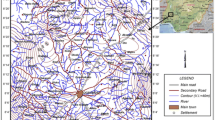Abstract
In part of a large abandoned mining complex, electromagnetic geophysical surveys were used along with data derived from cores and monitoring wells to infer sources of contamination and subsurface hydrologic connections between acidic refuse deposits and adjacent undisturbed geologic materials.
Electrical resistivity increases sharply along the boundary of an elevated deposit of pyritic coarse refuse, which is highly contaminated and electrically conductive, indicating poor subsurface hydrologic connections with surrounding deposits of fine refuse and undisturbed glacial material. Groundwater chemistry, as reflected in values of specific conductance, also differs markedly across the deposit's boundary, indicating that a widespread contaminant plume has not developed around the coarse refuse in more than 40 yr since the deposit was created. Most acidic drainage from the coarse refuse is by surface runoff and is concentrated around stream channels.
Although most of the contaminated groundwater within the study area is concentrated within the surficial refuse deposits, transects of apparent resistivity and phase angle indicate the existence of an anomalous conductive layer at depth (>4 m) in thick alluvial sediments along the northern boundary of the mining complex. Based on knowledge of local geology, the anomaly is interpreted to represent a subsurface connection between the alluvium and a flooded abandoned underground mine.
Similar content being viewed by others
References Cited
Bayless, E. R., G. A. Olyphant, and D. Harper, 1989, Field studies of acid drainage on an unreclaimed coal refuse pile in southwestern Indiana: Geological Society of America Abstracts with Programs, v. 21, no. 6, p. 192.
Brooks, G. A., 1990, An application of electromagnetic techniques to delineate acidic contamination at an abandoned coal mine in southwest Indiana: Unpublished MS Thesis, Indiana University, Bloomington, 211 p.
Cartwright, K., and M. R. McComas, 1968, Geophysical surveys in the vicinity of sanitary landfills in northeastern Illinois: Groundwater, v. 6, no. 5, p. 23–30.
Crossley, D. J., 1982, The theory of EM surface wave impedance measurements;in L. S. Collett and O. G. Jensen, eds., Geophysical applications of surface wave impedance measurements: Geological Survey of Canada, Paper 81-15, p. 1–17.
Ebraheem, A.M., M.W. Hamburger, E. R. Bayless, and N.C. Krothe, 1990, Application of earth resistivity methods to study groundwater contamination at the Wheatland reclamation site, southwestern Indiana: Groundwater, v. 28, no. 3, p. 361–368.
Fitterman, D. V., and G. A. Brooks, 1989, Geophysical investigation of depth to saltwater near the Herring River (Cape Cod National Seashore), Wellfleet, Massachusetts: U.S. Geological Survey Open-file Report, 55 p.
Geonics Limited, 1979, Operating manual for the EM-16, VLF-EM, and the EM-16R: Geonics Limited, Mississauga, Ontario, Canada, 80 p.
Indiana Geological Survey, 1989, Research and reclamation feasibility studies at the Friar Tuck Site, Sullivan and Greene Counties, Indiana: Second Annual Report (Part A) to the Indiana Division of Reclamation, Open-file Report, 145 p.
Kelly, W. E., 1976, Geoelectric sounding for delineating ground-water contamination: Groundwater, v. 14, no. 1, p. 6–10.
Mazac, O., W. E. Kelly, and I. Landa, 1987, Surface geoelectrics for groundwater pollution and protection studies: Journal of Hydrology, v. 93, no. 3, p. 277–294.
Merkel, R. H., 1972, The use of resistivity techniques to delineate acid mine drainage in ground water: Groundwater, v. 10, no. 5, p. 38–42.
Phillips, W. J., and W. E. Richards, 1975, A study of the effectiveness of the VLF method for the location of narrow mineralized fault zones: Geoexploration, v. 13, p. 215–226.
Stollar, R. L., and P. Roux, 1975, Earth resistivity surveys—a method for defining ground-water contamination: Groundwater, v. 13, no. 2, p. 145–150.
Thompson, D. B., 1987; A microcomputer program for interpreting time-lag permeability tests: Groundwater, v. 25, no. 2, p. 212–218.
Warner, D. L., 1969, Preliminary field studies using earth resistivity measurements for delineating zones of contaminated ground water: Groundwater, v. 7, no. 1, p. 9–16.
Zohdy, A. A. R., G. P. Eaton, and D. R. Mabey, 1974, Application of surface geophysics to groundwater investigations;in Techniques of water resources investigations; U.S. Geological Survey, Book 2, Chapter D1, 116 p.
Author information
Authors and Affiliations
Rights and permissions
About this article
Cite this article
Brooks, G.A., Olyphant, G.A. & Harper, D. Application of electromagnetic techniques in survey of contaminated groundwater at an abandoned mine complex in southwestern Indiana, U.S.A.. Environ. Geol. Water Sci 18, 39–47 (1991). https://doi.org/10.1007/BF01704576
Issue Date:
DOI: https://doi.org/10.1007/BF01704576




